Strategic Supply Chain Management Analysis of Amazon Inc. Network
VerifiedAdded on 2021/06/16
|11
|2843
|31
Report
AI Summary
This report provides a detailed analysis of Amazon Inc.'s strategic supply chain management. It explores Amazon's customer-centric approach, multi-tier inventory management system, advanced methodologies using information technology, and extensive warehouse network. The report examines how Amazon divides customer segments, utilizes push-pull strategies, and integrates its supply chain network. It highlights the evolution of Amazon's supply chain, including the expansion of its distribution system, the adoption of multi-tier inventory systems, and the integration of third-party courier services and its own Amazon Transportation Services. The report concludes by emphasizing the effectiveness of Amazon's supply chain network in gaining a competitive advantage, recommending continuous innovation and adaptation to maintain its leading position in the online retailing industry, and discussing future strategies like drone delivery systems.

Running Head: Supply Chain Network
Amazon Inc.
Strategic Supply Chain Management
Amazon Inc.
Strategic Supply Chain Management
Paraphrase This Document
Need a fresh take? Get an instant paraphrase of this document with our AI Paraphraser
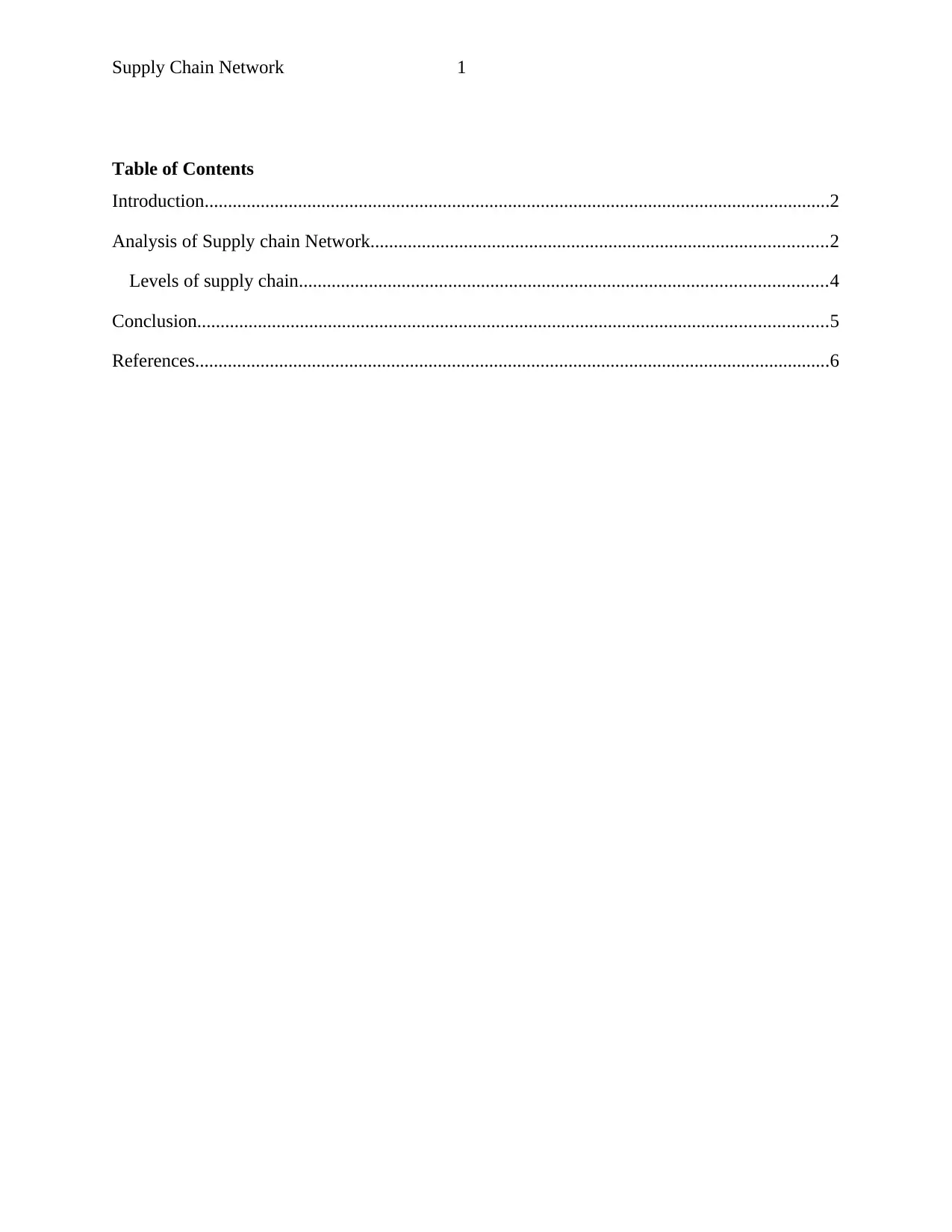
Supply Chain Network 1
Table of Contents
Introduction......................................................................................................................................2
Analysis of Supply chain Network..................................................................................................2
Levels of supply chain.................................................................................................................4
Conclusion.......................................................................................................................................5
References........................................................................................................................................6
Table of Contents
Introduction......................................................................................................................................2
Analysis of Supply chain Network..................................................................................................2
Levels of supply chain.................................................................................................................4
Conclusion.......................................................................................................................................5
References........................................................................................................................................6
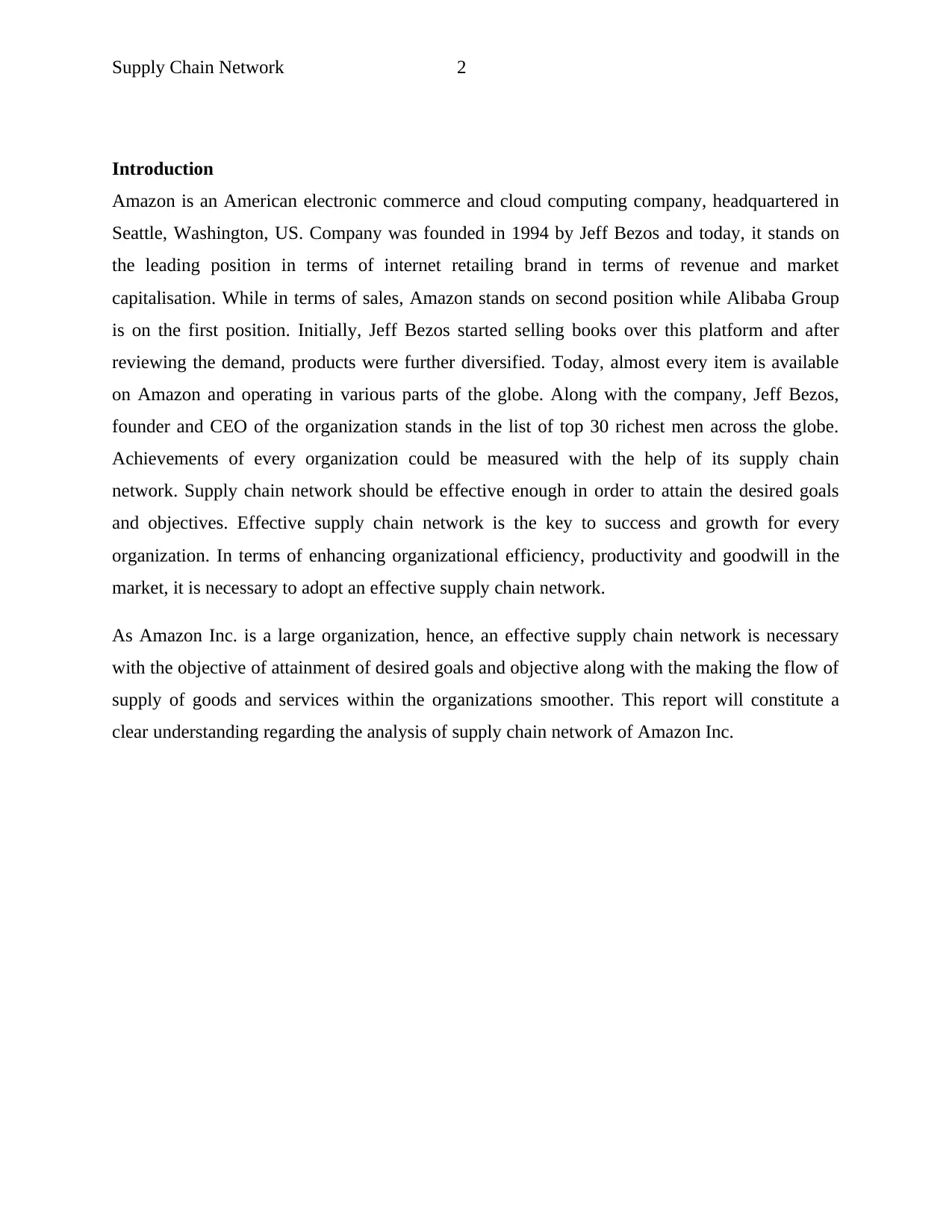
Supply Chain Network 2
Introduction
Amazon is an American electronic commerce and cloud computing company, headquartered in
Seattle, Washington, US. Company was founded in 1994 by Jeff Bezos and today, it stands on
the leading position in terms of internet retailing brand in terms of revenue and market
capitalisation. While in terms of sales, Amazon stands on second position while Alibaba Group
is on the first position. Initially, Jeff Bezos started selling books over this platform and after
reviewing the demand, products were further diversified. Today, almost every item is available
on Amazon and operating in various parts of the globe. Along with the company, Jeff Bezos,
founder and CEO of the organization stands in the list of top 30 richest men across the globe.
Achievements of every organization could be measured with the help of its supply chain
network. Supply chain network should be effective enough in order to attain the desired goals
and objectives. Effective supply chain network is the key to success and growth for every
organization. In terms of enhancing organizational efficiency, productivity and goodwill in the
market, it is necessary to adopt an effective supply chain network.
As Amazon Inc. is a large organization, hence, an effective supply chain network is necessary
with the objective of attainment of desired goals and objective along with the making the flow of
supply of goods and services within the organizations smoother. This report will constitute a
clear understanding regarding the analysis of supply chain network of Amazon Inc.
Introduction
Amazon is an American electronic commerce and cloud computing company, headquartered in
Seattle, Washington, US. Company was founded in 1994 by Jeff Bezos and today, it stands on
the leading position in terms of internet retailing brand in terms of revenue and market
capitalisation. While in terms of sales, Amazon stands on second position while Alibaba Group
is on the first position. Initially, Jeff Bezos started selling books over this platform and after
reviewing the demand, products were further diversified. Today, almost every item is available
on Amazon and operating in various parts of the globe. Along with the company, Jeff Bezos,
founder and CEO of the organization stands in the list of top 30 richest men across the globe.
Achievements of every organization could be measured with the help of its supply chain
network. Supply chain network should be effective enough in order to attain the desired goals
and objectives. Effective supply chain network is the key to success and growth for every
organization. In terms of enhancing organizational efficiency, productivity and goodwill in the
market, it is necessary to adopt an effective supply chain network.
As Amazon Inc. is a large organization, hence, an effective supply chain network is necessary
with the objective of attainment of desired goals and objective along with the making the flow of
supply of goods and services within the organizations smoother. This report will constitute a
clear understanding regarding the analysis of supply chain network of Amazon Inc.
⊘ This is a preview!⊘
Do you want full access?
Subscribe today to unlock all pages.

Trusted by 1+ million students worldwide

Supply Chain Network 3
Analysis of Supply chain Network
Amazon’s supply chain management is an effective approach through which competitive
advantage could easily be attained. Organization has adopted customer centric approach with the
objective of fulfilment of its target audience’s articulated as well as unarticulated demands. This
has makes the company more efficient and ultimately, organization has developed an effective
goodwill amongst the target audience. Supply chain network of Amazon includes advanced
procedures such as multi-tier inventory management system, advanced methodologies with the
use of information technology, superlative transportation and huge network of advance
warehouses. Combination of all these procedures forms an effective supply chain management
for Amazon and this network also acts as defensive strategy to maintain the acquired position in
the global market (Ahi & Searcy, 2013).
Apart from this, outsourcing the inventory is another crucial aspect for an effective supply chain
management system. Amazon uses to outsource the distribution of those products which are not
purchased by customers frequently as well as not ordered on immediate delivery basis. Along
with those products, the products whose storing cost is much higher than the profit margin are
also outsourced with the motive of reducing cost. On the other hand, Amazon uses to store the
frequently purchased products in their own warehouses with the objective of making fulfilment
of customer’s needs and desires. In order to gain better outcomes, organization has introduced
fast delivery option especially for the frequently purchased products in relation with making the
goods available quickly for the consumers in comparison with the standard delivery time. In
other words, by segregating its inventory, Amazon is able to be responsive to the customers as
well as cut costs or cut slack where it is needed (Monczka, Handfield, Giunipero & Patterson,
2015). In order to gain competitive advantage as well as to enhance its productivity for fulfilling
its target audience’s demands and wants, organization has adopted following strategies:
Divides customer segments: Customers are divided on the basis of their chosen method
for delivery. Amazon offers various forms of delivery such as one day delivery, free
super saver delivery, prime customers delivery and first class delivery. This has been
introduced with the objective of fulfilling customer’s needs quickly and making them
realise their importance. All these segments are considered significant for organizational
Analysis of Supply chain Network
Amazon’s supply chain management is an effective approach through which competitive
advantage could easily be attained. Organization has adopted customer centric approach with the
objective of fulfilment of its target audience’s articulated as well as unarticulated demands. This
has makes the company more efficient and ultimately, organization has developed an effective
goodwill amongst the target audience. Supply chain network of Amazon includes advanced
procedures such as multi-tier inventory management system, advanced methodologies with the
use of information technology, superlative transportation and huge network of advance
warehouses. Combination of all these procedures forms an effective supply chain management
for Amazon and this network also acts as defensive strategy to maintain the acquired position in
the global market (Ahi & Searcy, 2013).
Apart from this, outsourcing the inventory is another crucial aspect for an effective supply chain
management system. Amazon uses to outsource the distribution of those products which are not
purchased by customers frequently as well as not ordered on immediate delivery basis. Along
with those products, the products whose storing cost is much higher than the profit margin are
also outsourced with the motive of reducing cost. On the other hand, Amazon uses to store the
frequently purchased products in their own warehouses with the objective of making fulfilment
of customer’s needs and desires. In order to gain better outcomes, organization has introduced
fast delivery option especially for the frequently purchased products in relation with making the
goods available quickly for the consumers in comparison with the standard delivery time. In
other words, by segregating its inventory, Amazon is able to be responsive to the customers as
well as cut costs or cut slack where it is needed (Monczka, Handfield, Giunipero & Patterson,
2015). In order to gain competitive advantage as well as to enhance its productivity for fulfilling
its target audience’s demands and wants, organization has adopted following strategies:
Divides customer segments: Customers are divided on the basis of their chosen method
for delivery. Amazon offers various forms of delivery such as one day delivery, free
super saver delivery, prime customers delivery and first class delivery. This has been
introduced with the objective of fulfilling customer’s needs quickly and making them
realise their importance. All these segments are considered significant for organizational
Paraphrase This Document
Need a fresh take? Get an instant paraphrase of this document with our AI Paraphraser

Supply Chain Network 4
growth and for this purpose; Amazon offers fast delivery option by paying a certain
amount extra over the price of the product in terms of saving time as well as getting the
required products quickly as possible (Christopher, 2016). In terms of making available
the goods quickly, organization needs to store the products in its own warehouses which
are known as Amazon fulfilment centres. While initially, organization was working as a
mediator between buyers and sellers and there was no cost involved for storing the
products but now with the introduction of fast delivery options, organization is required
to store seller’s products in its own centres so that they could be delivered quickly
(Wisner, Tan & Leong, 2014).
In terms of attaining better results and growth, organization uses to improve its supply
chain network by adopting various advanced measures in terms of technology. Main
motive behind doing this is attainment of desired goals and objectives as well as to retain
its efficiency with changing time and trends (Fawcett, Wallin, Allred, Fawcett &
Magnan, 2011).
Gradually and slowly, Amazon has opened various fulfilment centres across the globe and stores
varieties of products sold by sellers. For this, company also charge a nominal amount from
sellers in return for keeping safe and secure. Amazon has adopted push-pull strategy with regards
to improvise its functioning as well as to enhance its productivity. In push-pull strategy,
inventory is held in push strategy whereas the shipment of orders is done in pull strategy. This
strategy is being adopted for frequent purchased products whereas Amazon is still practicing pull
strategy for the products which outsourced for distribution as well as for those products which
are not stocked (Zott & Amit, 2010).
Multi-tier inventory system acts as the backbone for organizational effective supply chain
network. In terms of multi-tier system, first-tier is the accumulation amongst the distribution
centres. Under this, company ensures that fewer inventory is being stored and too on the basis of
frequency of their demand. Along with this, company responds to the consumer’s demand in
dynamic manner. Further moving, next tier is focus over partner distribution centres and the
wholesalers. Under this system, whenever company lacks with the ordered product from
customers, it rely on its partners and wholesalers to supply the required products to the customers
on behalf of Amazon. Moving further, with the help of sophisticated and real time IT system,
growth and for this purpose; Amazon offers fast delivery option by paying a certain
amount extra over the price of the product in terms of saving time as well as getting the
required products quickly as possible (Christopher, 2016). In terms of making available
the goods quickly, organization needs to store the products in its own warehouses which
are known as Amazon fulfilment centres. While initially, organization was working as a
mediator between buyers and sellers and there was no cost involved for storing the
products but now with the introduction of fast delivery options, organization is required
to store seller’s products in its own centres so that they could be delivered quickly
(Wisner, Tan & Leong, 2014).
In terms of attaining better results and growth, organization uses to improve its supply
chain network by adopting various advanced measures in terms of technology. Main
motive behind doing this is attainment of desired goals and objectives as well as to retain
its efficiency with changing time and trends (Fawcett, Wallin, Allred, Fawcett &
Magnan, 2011).
Gradually and slowly, Amazon has opened various fulfilment centres across the globe and stores
varieties of products sold by sellers. For this, company also charge a nominal amount from
sellers in return for keeping safe and secure. Amazon has adopted push-pull strategy with regards
to improvise its functioning as well as to enhance its productivity. In push-pull strategy,
inventory is held in push strategy whereas the shipment of orders is done in pull strategy. This
strategy is being adopted for frequent purchased products whereas Amazon is still practicing pull
strategy for the products which outsourced for distribution as well as for those products which
are not stocked (Zott & Amit, 2010).
Multi-tier inventory system acts as the backbone for organizational effective supply chain
network. In terms of multi-tier system, first-tier is the accumulation amongst the distribution
centres. Under this, company ensures that fewer inventory is being stored and too on the basis of
frequency of their demand. Along with this, company responds to the consumer’s demand in
dynamic manner. Further moving, next tier is focus over partner distribution centres and the
wholesalers. Under this system, whenever company lacks with the ordered product from
customers, it rely on its partners and wholesalers to supply the required products to the customers
on behalf of Amazon. Moving further, with the help of sophisticated and real time IT system,
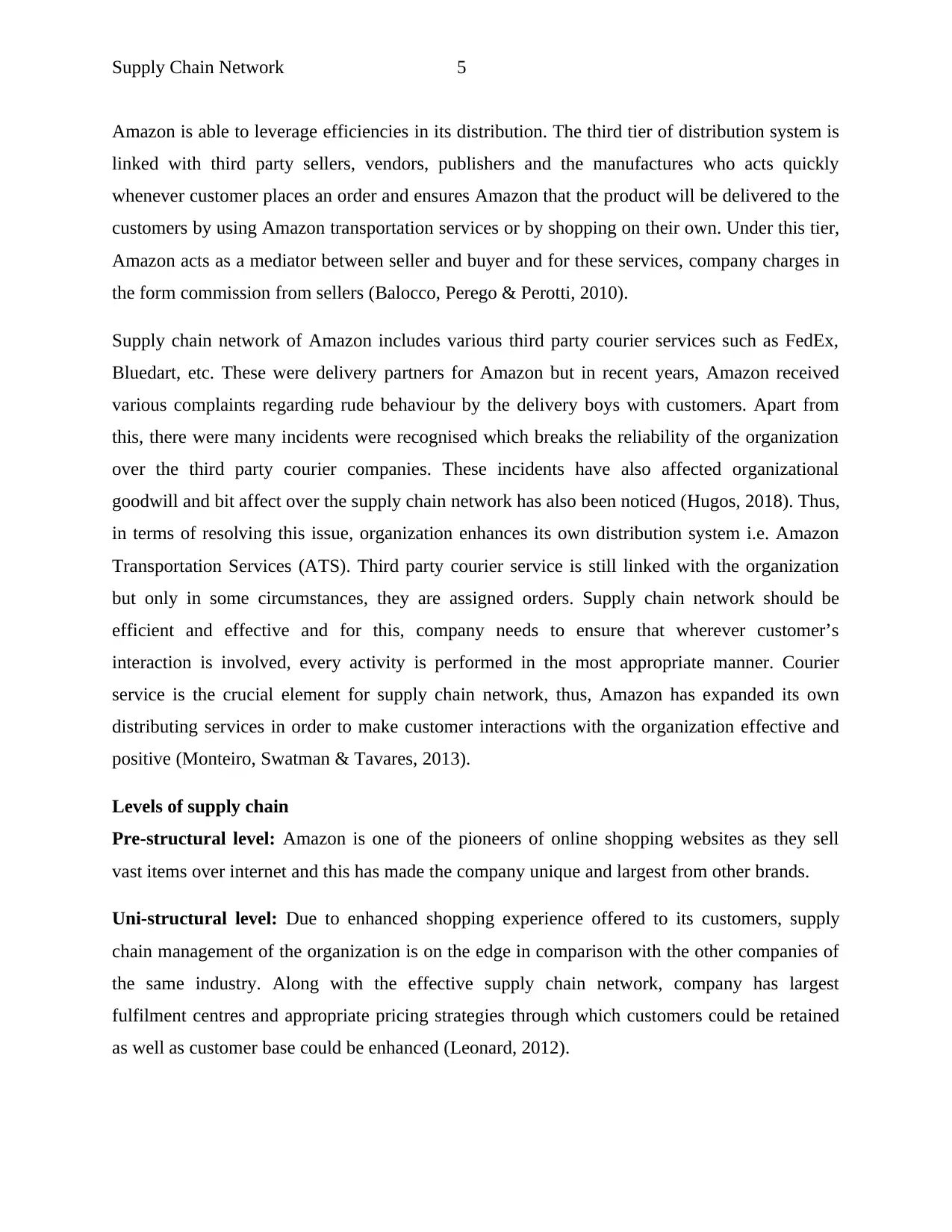
Supply Chain Network 5
Amazon is able to leverage efficiencies in its distribution. The third tier of distribution system is
linked with third party sellers, vendors, publishers and the manufactures who acts quickly
whenever customer places an order and ensures Amazon that the product will be delivered to the
customers by using Amazon transportation services or by shopping on their own. Under this tier,
Amazon acts as a mediator between seller and buyer and for these services, company charges in
the form commission from sellers (Balocco, Perego & Perotti, 2010).
Supply chain network of Amazon includes various third party courier services such as FedEx,
Bluedart, etc. These were delivery partners for Amazon but in recent years, Amazon received
various complaints regarding rude behaviour by the delivery boys with customers. Apart from
this, there were many incidents were recognised which breaks the reliability of the organization
over the third party courier companies. These incidents have also affected organizational
goodwill and bit affect over the supply chain network has also been noticed (Hugos, 2018). Thus,
in terms of resolving this issue, organization enhances its own distribution system i.e. Amazon
Transportation Services (ATS). Third party courier service is still linked with the organization
but only in some circumstances, they are assigned orders. Supply chain network should be
efficient and effective and for this, company needs to ensure that wherever customer’s
interaction is involved, every activity is performed in the most appropriate manner. Courier
service is the crucial element for supply chain network, thus, Amazon has expanded its own
distributing services in order to make customer interactions with the organization effective and
positive (Monteiro, Swatman & Tavares, 2013).
Levels of supply chain
Pre-structural level: Amazon is one of the pioneers of online shopping websites as they sell
vast items over internet and this has made the company unique and largest from other brands.
Uni-structural level: Due to enhanced shopping experience offered to its customers, supply
chain management of the organization is on the edge in comparison with the other companies of
the same industry. Along with the effective supply chain network, company has largest
fulfilment centres and appropriate pricing strategies through which customers could be retained
as well as customer base could be enhanced (Leonard, 2012).
Amazon is able to leverage efficiencies in its distribution. The third tier of distribution system is
linked with third party sellers, vendors, publishers and the manufactures who acts quickly
whenever customer places an order and ensures Amazon that the product will be delivered to the
customers by using Amazon transportation services or by shopping on their own. Under this tier,
Amazon acts as a mediator between seller and buyer and for these services, company charges in
the form commission from sellers (Balocco, Perego & Perotti, 2010).
Supply chain network of Amazon includes various third party courier services such as FedEx,
Bluedart, etc. These were delivery partners for Amazon but in recent years, Amazon received
various complaints regarding rude behaviour by the delivery boys with customers. Apart from
this, there were many incidents were recognised which breaks the reliability of the organization
over the third party courier companies. These incidents have also affected organizational
goodwill and bit affect over the supply chain network has also been noticed (Hugos, 2018). Thus,
in terms of resolving this issue, organization enhances its own distribution system i.e. Amazon
Transportation Services (ATS). Third party courier service is still linked with the organization
but only in some circumstances, they are assigned orders. Supply chain network should be
efficient and effective and for this, company needs to ensure that wherever customer’s
interaction is involved, every activity is performed in the most appropriate manner. Courier
service is the crucial element for supply chain network, thus, Amazon has expanded its own
distributing services in order to make customer interactions with the organization effective and
positive (Monteiro, Swatman & Tavares, 2013).
Levels of supply chain
Pre-structural level: Amazon is one of the pioneers of online shopping websites as they sell
vast items over internet and this has made the company unique and largest from other brands.
Uni-structural level: Due to enhanced shopping experience offered to its customers, supply
chain management of the organization is on the edge in comparison with the other companies of
the same industry. Along with the effective supply chain network, company has largest
fulfilment centres and appropriate pricing strategies through which customers could be retained
as well as customer base could be enhanced (Leonard, 2012).
⊘ This is a preview!⊘
Do you want full access?
Subscribe today to unlock all pages.

Trusted by 1+ million students worldwide

Supply Chain Network 6
Multi-structural level: In terms of introduction of rating system, Amazon was the first company
to do so. Under this service, customers could rate the services offered by the company along with
the quality of products delivered to them. Along with their own brand, Amazon sells various
other brands’ products over internet which makes them the largest online retailer company
(Lambert & Schwieterman, 2012).
Relational level: Amazon’s growth and success could be analysed by reviewing that the major
brick and mortar retailers like Borders and Toys ‘R’ and Target Corp uses Amazon’s services for
selling their items over internet. The major reason behind is the multi-tier inventory management
adopted by Amazon and effective management of inventory by the organization.
Critical level: Amazon’s operations are conducted at international level. Company operates in
more than 200 countries across the globe. Management of operations is plays crucial role in
order to avoid the glitches and Amazon has attained appropriate success in doing this (Tseng,
2014).
Amazon is operating with cooperation model with its suppliers and in order to integrate its
supply chain network, organization could move towards ‘bullwhip’ model. Along with this,
organization could adopt coordination model in order to develop better relations with its
suppliers. With the help of ‘bullwhip’ strategy, organization would be able to share information
amongst the partners, suppliers and other concerned parties through a latest technology.
Technology is another significant aspect for an organization to enhance its performance. Thus, it
could be said that Amazon’s supply chain management is simple, yet effective. In 2015,
Amazon’s supply chain management was awarded as the top system by Gartner Inc.’s top 25
supply chain networks. Amazon beats McDonald’s and Unilever. The major reason behind is the
adaptation of effective approaches by the organization. Customer centric approach and regularity
in innovating new strategies to improvise the customer interaction with the organization effective
are certain crucial aspects of organizational continuous growth and success (Prajogo,
Chowdhury, Yeung & Cheng, 2012).
Patience, relentless investment and serial innovation have helped Jeff Bezos’s company “shred
the competition”. In near future, almost 85% of the total products across the globe will be made
available on Amazon’s website. This will made the company to stand on the peak position before
Multi-structural level: In terms of introduction of rating system, Amazon was the first company
to do so. Under this service, customers could rate the services offered by the company along with
the quality of products delivered to them. Along with their own brand, Amazon sells various
other brands’ products over internet which makes them the largest online retailer company
(Lambert & Schwieterman, 2012).
Relational level: Amazon’s growth and success could be analysed by reviewing that the major
brick and mortar retailers like Borders and Toys ‘R’ and Target Corp uses Amazon’s services for
selling their items over internet. The major reason behind is the multi-tier inventory management
adopted by Amazon and effective management of inventory by the organization.
Critical level: Amazon’s operations are conducted at international level. Company operates in
more than 200 countries across the globe. Management of operations is plays crucial role in
order to avoid the glitches and Amazon has attained appropriate success in doing this (Tseng,
2014).
Amazon is operating with cooperation model with its suppliers and in order to integrate its
supply chain network, organization could move towards ‘bullwhip’ model. Along with this,
organization could adopt coordination model in order to develop better relations with its
suppliers. With the help of ‘bullwhip’ strategy, organization would be able to share information
amongst the partners, suppliers and other concerned parties through a latest technology.
Technology is another significant aspect for an organization to enhance its performance. Thus, it
could be said that Amazon’s supply chain management is simple, yet effective. In 2015,
Amazon’s supply chain management was awarded as the top system by Gartner Inc.’s top 25
supply chain networks. Amazon beats McDonald’s and Unilever. The major reason behind is the
adaptation of effective approaches by the organization. Customer centric approach and regularity
in innovating new strategies to improvise the customer interaction with the organization effective
are certain crucial aspects of organizational continuous growth and success (Prajogo,
Chowdhury, Yeung & Cheng, 2012).
Patience, relentless investment and serial innovation have helped Jeff Bezos’s company “shred
the competition”. In near future, almost 85% of the total products across the globe will be made
available on Amazon’s website. This will made the company to stand on the peak position before
Paraphrase This Document
Need a fresh take? Get an instant paraphrase of this document with our AI Paraphraser
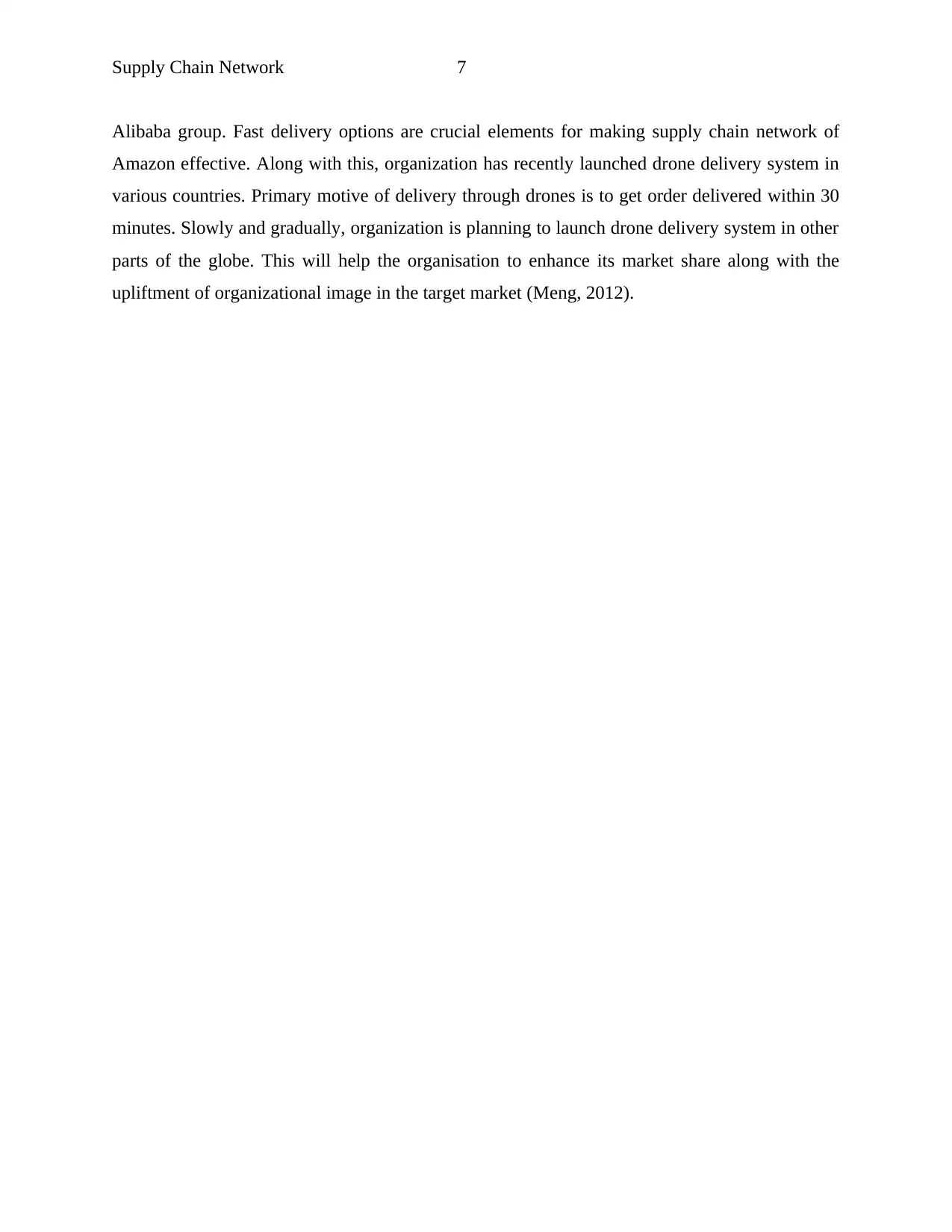
Supply Chain Network 7
Alibaba group. Fast delivery options are crucial elements for making supply chain network of
Amazon effective. Along with this, organization has recently launched drone delivery system in
various countries. Primary motive of delivery through drones is to get order delivered within 30
minutes. Slowly and gradually, organization is planning to launch drone delivery system in other
parts of the globe. This will help the organisation to enhance its market share along with the
upliftment of organizational image in the target market (Meng, 2012).
Alibaba group. Fast delivery options are crucial elements for making supply chain network of
Amazon effective. Along with this, organization has recently launched drone delivery system in
various countries. Primary motive of delivery through drones is to get order delivered within 30
minutes. Slowly and gradually, organization is planning to launch drone delivery system in other
parts of the globe. This will help the organisation to enhance its market share along with the
upliftment of organizational image in the target market (Meng, 2012).
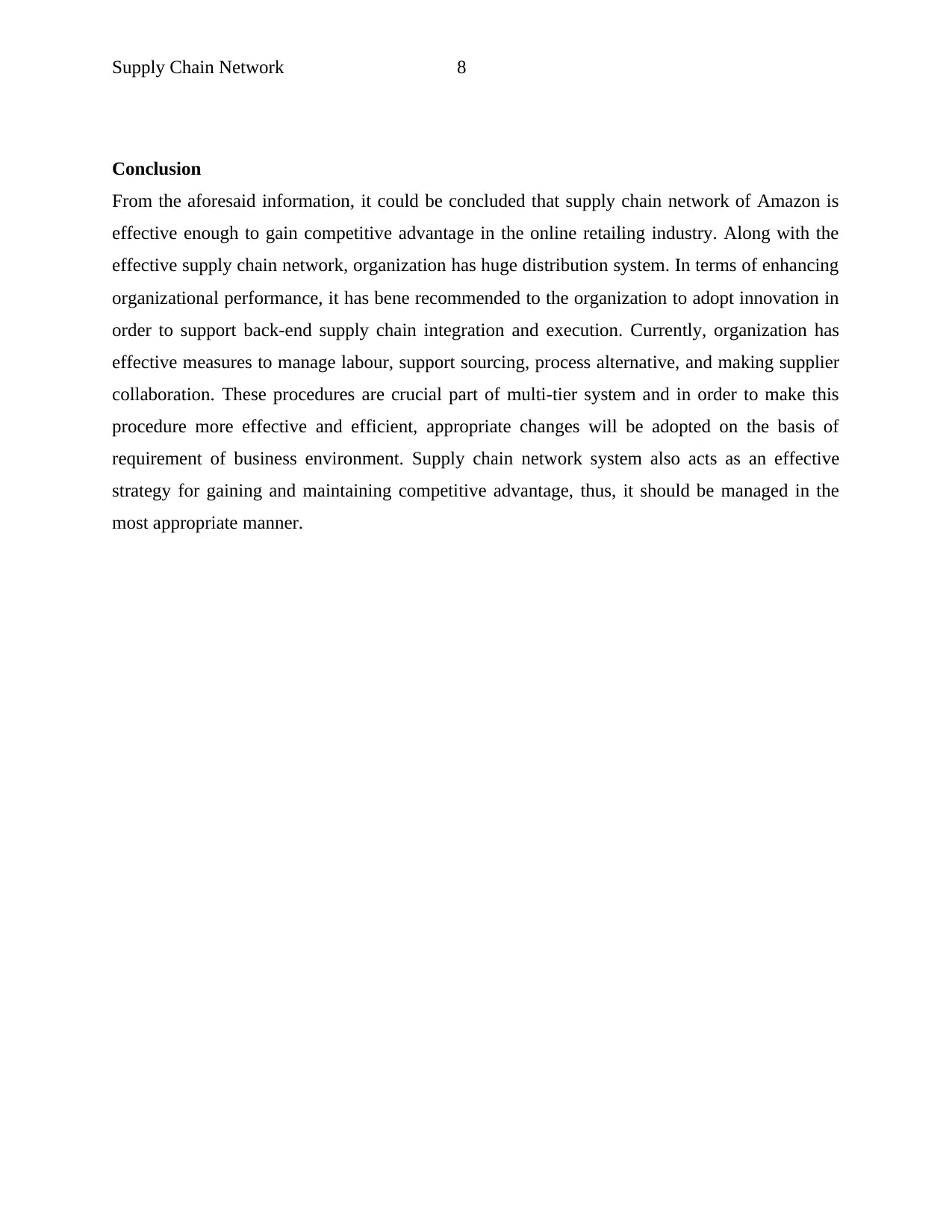
Supply Chain Network 8
Conclusion
From the aforesaid information, it could be concluded that supply chain network of Amazon is
effective enough to gain competitive advantage in the online retailing industry. Along with the
effective supply chain network, organization has huge distribution system. In terms of enhancing
organizational performance, it has bene recommended to the organization to adopt innovation in
order to support back-end supply chain integration and execution. Currently, organization has
effective measures to manage labour, support sourcing, process alternative, and making supplier
collaboration. These procedures are crucial part of multi-tier system and in order to make this
procedure more effective and efficient, appropriate changes will be adopted on the basis of
requirement of business environment. Supply chain network system also acts as an effective
strategy for gaining and maintaining competitive advantage, thus, it should be managed in the
most appropriate manner.
Conclusion
From the aforesaid information, it could be concluded that supply chain network of Amazon is
effective enough to gain competitive advantage in the online retailing industry. Along with the
effective supply chain network, organization has huge distribution system. In terms of enhancing
organizational performance, it has bene recommended to the organization to adopt innovation in
order to support back-end supply chain integration and execution. Currently, organization has
effective measures to manage labour, support sourcing, process alternative, and making supplier
collaboration. These procedures are crucial part of multi-tier system and in order to make this
procedure more effective and efficient, appropriate changes will be adopted on the basis of
requirement of business environment. Supply chain network system also acts as an effective
strategy for gaining and maintaining competitive advantage, thus, it should be managed in the
most appropriate manner.
⊘ This is a preview!⊘
Do you want full access?
Subscribe today to unlock all pages.

Trusted by 1+ million students worldwide
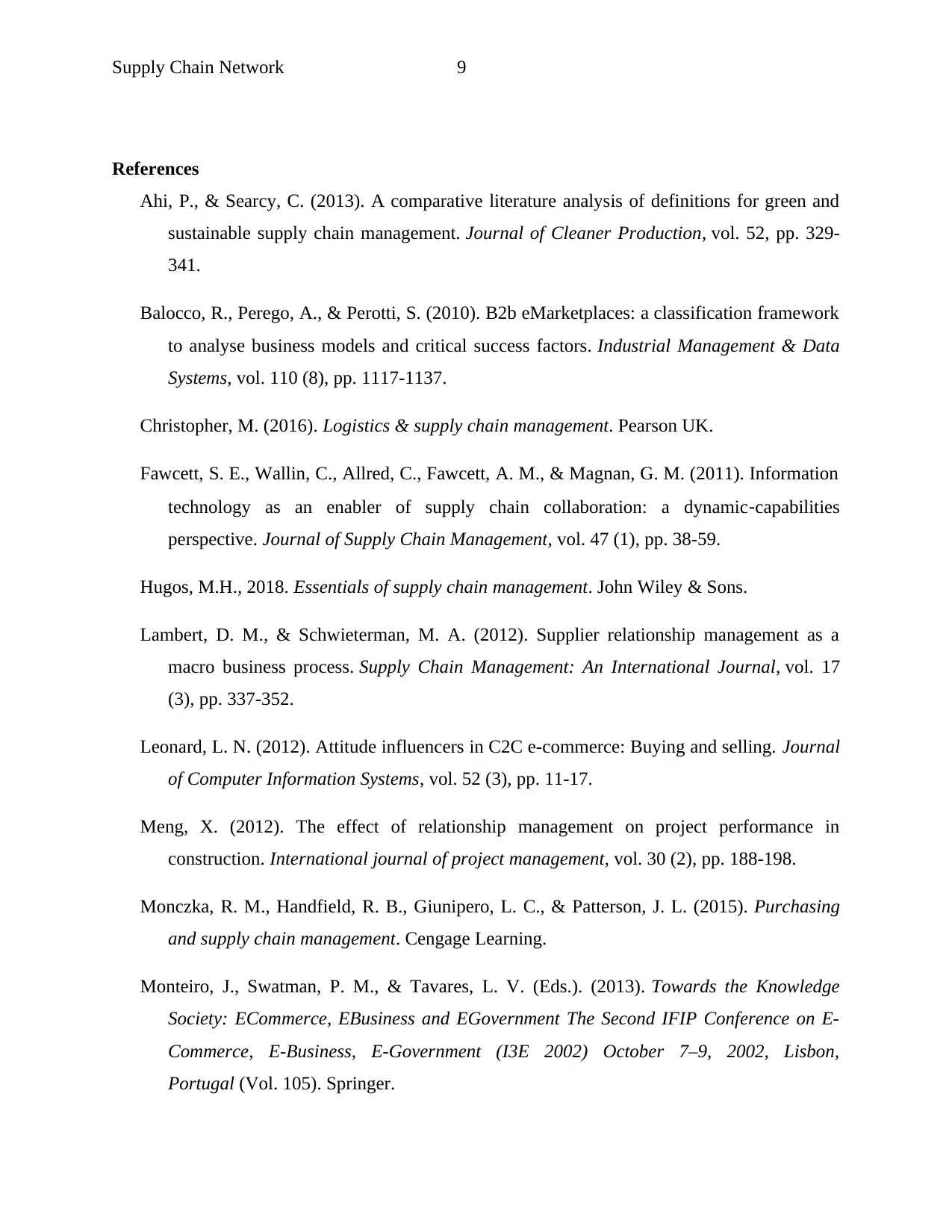
Supply Chain Network 9
References
Ahi, P., & Searcy, C. (2013). A comparative literature analysis of definitions for green and
sustainable supply chain management. Journal of Cleaner Production, vol. 52, pp. 329-
341.
Balocco, R., Perego, A., & Perotti, S. (2010). B2b eMarketplaces: a classification framework
to analyse business models and critical success factors. Industrial Management & Data
Systems, vol. 110 (8), pp. 1117-1137.
Christopher, M. (2016). Logistics & supply chain management. Pearson UK.
Fawcett, S. E., Wallin, C., Allred, C., Fawcett, A. M., & Magnan, G. M. (2011). Information
technology as an enabler of supply chain collaboration: a dynamic‐capabilities
perspective. Journal of Supply Chain Management, vol. 47 (1), pp. 38-59.
Hugos, M.H., 2018. Essentials of supply chain management. John Wiley & Sons.
Lambert, D. M., & Schwieterman, M. A. (2012). Supplier relationship management as a
macro business process. Supply Chain Management: An International Journal, vol. 17
(3), pp. 337-352.
Leonard, L. N. (2012). Attitude influencers in C2C e-commerce: Buying and selling. Journal
of Computer Information Systems, vol. 52 (3), pp. 11-17.
Meng, X. (2012). The effect of relationship management on project performance in
construction. International journal of project management, vol. 30 (2), pp. 188-198.
Monczka, R. M., Handfield, R. B., Giunipero, L. C., & Patterson, J. L. (2015). Purchasing
and supply chain management. Cengage Learning.
Monteiro, J., Swatman, P. M., & Tavares, L. V. (Eds.). (2013). Towards the Knowledge
Society: ECommerce, EBusiness and EGovernment The Second IFIP Conference on E-
Commerce, E-Business, E-Government (I3E 2002) October 7–9, 2002, Lisbon,
Portugal (Vol. 105). Springer.
References
Ahi, P., & Searcy, C. (2013). A comparative literature analysis of definitions for green and
sustainable supply chain management. Journal of Cleaner Production, vol. 52, pp. 329-
341.
Balocco, R., Perego, A., & Perotti, S. (2010). B2b eMarketplaces: a classification framework
to analyse business models and critical success factors. Industrial Management & Data
Systems, vol. 110 (8), pp. 1117-1137.
Christopher, M. (2016). Logistics & supply chain management. Pearson UK.
Fawcett, S. E., Wallin, C., Allred, C., Fawcett, A. M., & Magnan, G. M. (2011). Information
technology as an enabler of supply chain collaboration: a dynamic‐capabilities
perspective. Journal of Supply Chain Management, vol. 47 (1), pp. 38-59.
Hugos, M.H., 2018. Essentials of supply chain management. John Wiley & Sons.
Lambert, D. M., & Schwieterman, M. A. (2012). Supplier relationship management as a
macro business process. Supply Chain Management: An International Journal, vol. 17
(3), pp. 337-352.
Leonard, L. N. (2012). Attitude influencers in C2C e-commerce: Buying and selling. Journal
of Computer Information Systems, vol. 52 (3), pp. 11-17.
Meng, X. (2012). The effect of relationship management on project performance in
construction. International journal of project management, vol. 30 (2), pp. 188-198.
Monczka, R. M., Handfield, R. B., Giunipero, L. C., & Patterson, J. L. (2015). Purchasing
and supply chain management. Cengage Learning.
Monteiro, J., Swatman, P. M., & Tavares, L. V. (Eds.). (2013). Towards the Knowledge
Society: ECommerce, EBusiness and EGovernment The Second IFIP Conference on E-
Commerce, E-Business, E-Government (I3E 2002) October 7–9, 2002, Lisbon,
Portugal (Vol. 105). Springer.
Paraphrase This Document
Need a fresh take? Get an instant paraphrase of this document with our AI Paraphraser

Supply Chain Network 10
Prajogo, D., Chowdhury, M., Yeung, A. C., & Cheng, T. C. E. (2012). The relationship
between supplier management and firm's operational performance: A multi-dimensional
perspective. International Journal of Production Economics, vol. 136 (1), pp. 123-130.
Tseng, S. M. (2014). The impact of knowledge management capabilities and supplier
relationship management on corporate performance. International Journal of Production
Economics, vol. 154, pp. 39-47.
Wisner, J. D., Tan, K. C., & Leong, G. K. (2014). Principles of supply chain management: A
balanced approach. Cengage Learning.
Zott, C., & Amit, R. (2010). Business model design: an activity system perspective. Long
range planning, vol. 43 (2), pp. 216-226.
Prajogo, D., Chowdhury, M., Yeung, A. C., & Cheng, T. C. E. (2012). The relationship
between supplier management and firm's operational performance: A multi-dimensional
perspective. International Journal of Production Economics, vol. 136 (1), pp. 123-130.
Tseng, S. M. (2014). The impact of knowledge management capabilities and supplier
relationship management on corporate performance. International Journal of Production
Economics, vol. 154, pp. 39-47.
Wisner, J. D., Tan, K. C., & Leong, G. K. (2014). Principles of supply chain management: A
balanced approach. Cengage Learning.
Zott, C., & Amit, R. (2010). Business model design: an activity system perspective. Long
range planning, vol. 43 (2), pp. 216-226.
1 out of 11
Related Documents
Your All-in-One AI-Powered Toolkit for Academic Success.
+13062052269
info@desklib.com
Available 24*7 on WhatsApp / Email
![[object Object]](/_next/static/media/star-bottom.7253800d.svg)
Unlock your academic potential
Copyright © 2020–2025 A2Z Services. All Rights Reserved. Developed and managed by ZUCOL.




